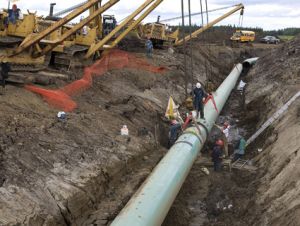Crossing One Of World's Largest Aquifers ~ Keystone XL Will Not Use Advanced Leak Detection
 Even after causing more than a dozen spills in 2011 from its newest tar sands pipeline — including a six story “geyser” of crude — Canadian energy developer TransCanada claimed its planned Keystone XL pipeline would “exceed” safety standards.
Even after causing more than a dozen spills in 2011 from its newest tar sands pipeline — including a six story “geyser” of crude — Canadian energy developer TransCanada claimed its planned Keystone XL pipeline would “exceed” safety standards.But according to a new investigation of TransCanada’s development plans, the company does not plan to use advanced spill prevention technologies on a section of pipeline that would cross an underground reservoir providing nearly 30 percent of America’s irrigation water.
InsideClimate News reported this week that TransCanada would only use standard leak detection technologies across a 19-mile stretch of the pristine Ogallala Aquifer, making bigger leaks more likely:
The leak detection technology that will be used on the Keystone XL, for instance, is standard for the nation’s crude oil pipelines and rarely detects leaks smaller than 1 percent of the pipeline’s flow. The Keystone will have a capacity of 29 million gallons per day—so a spill would have to reach 294,000 gallons per day to trigger its leak detection technology.
The Keystone XL also won’t get two other safeguards found on the 19-mile stretch of the pipeline over Austin’s aquifer: a concrete cap that protects the Longhorn from construction-related punctures, and daily aerial or foot patrols to check for tiny spills that might seep to the surface.
Experts interviewed by InsideClimate News estimate it would cost less than $10 million—roughly 0.2 percent of the Keystone’s $5.3 billion budget—to add external sensor cables, a concrete cap and extra patrols to the 20 miles of the pipeline in Nebraska where a spill would be most disastrous. The water table in that area lies less than 20 feet below the surface and provides ranchers with a steady supply of fresh water.
Keystone XL is a proposed 1,200 mile pipeline that would carry tar sands crude from Alberta, Canada to refineries in the Gulf Coast for sale into the global market. The pipeline has been a central target of environmental groups because of concerns about its impact on local water quality and contribution to global warming.
Tar sands crude requires an enormous amount of energy and water to mine and process — making it up to 80 percent more carbon-intensive than conventional crude. NASA climatologist James Hansen calls development of tar sands “game over” for the climate.
Local worries about the impact of a tar sands oil spill have also sparked a movement in Nebraska banding environmentalists, farmers, and other landowners together in an effort to stop the project:
Much of the opposition to the Keystone XL has focused on the type of oil it would carry: Bitumen is a particularly heavy form of crude oil extracted from Canada’s tar sands region. It is so thick that it can’t flow through pipelines until it’s diluted with liquid chemicals to form what’s known as diluted bitumen or “dilbit.”
The same federal standards that apply to gasoline and crude oil pipelines also apply to pipelines carrying dilbit—even though dilbit doesn’t behave like conventional crude oil when it spills into water.
The nation’s first major dilbit spill occurred in July 2010, when a ruptured pipeline released a million gallons of dilbit into the Kalamazoo River. As the light, liquid chemicals in dilbit began evaporating, the heavy bitumen sank into the river. Nearly two and a half years later, Enbridge Inc., the Canadian company that owns the ruptured pipeline, is still struggling to clean up the Kalamazoo. The current cost of clean up exceeds $800 million.
The Enbridge accident showed what happens when dilbit spills into a river. But little is known about how dilbit might behave in an aquifer, said Wayne Woldt, a University of Nebraska-Lincoln professor who studies groundwater management.
Once an aquifer is contaminated, it’s virtually impossible to restore it to its pristine condition, Woldt said. The extent of damage would depend on the size of the spill and on how the dilbit moves within the aquifer.
In January, concerns about a possible spill increased after a pipeline inspector working on TransCanada’s original Keystone project issued a warning about the company’s record on quality:
What did I see? Cheap foreign steel that cracked when workers tried to weld it, foundations for pump stations that you would never consider using in your own home, fudged safety tests, Bechtel staffers explaining away leaks during pressure tests as “not too bad,” shortcuts on the steel and rebar that are essential for safe pipeline operation and siting of facilities on completely inappropriate spots like wetlands.
I shared these concerns with my bosses, who communicated them to the bigwigs at TransCanada, but nothing changed. TransCanada didn’t appear to care. That is why I was not surprised to hear about the big spill in Ludden, N.D., where a 60-foot plume of crude spewed tens of thousands of gallons of toxic tar sands oil and fouled neighboring fields.
Environmentalists and climate advocates have made killing Keystone XL their top priority for the beginning of President Obama’s second term.
Last month, 350.org organized a rally outside the White House to remind the Administration that people were still paying close attention to the issue. And in February, the Sierra Club, 350.org, and other environmental groups will hold a much bigger demonstration in Washington, likely around the time that the President will be forced to approve or deny the controversial project.
You can return to the main Market News page, or press the Back button on your browser.

